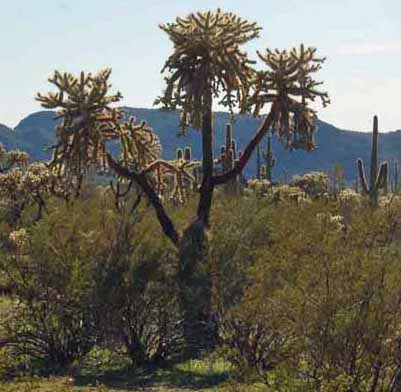the wandering chick
...Organ Pipe Cactus Natl. Monument
and Ajo, both in southwest Arizona
The hottest enchilada in the Organ Pipe Cactus Natl Monument is, take a guess, the organ pipe cactus, seen above and to the right. This remarkable type of cactus is found almost exclusively in this area of the U.S. They rise up to 16 feet high and to 12 feet in diameter. Other types of cacti can be found in the park, such as the saguaro and cholla, but it's the organ pipe that really catches your eye.
The national monument is more than 330,000 acres, and 75% of that is considered wilderness. You feel you are truly in the middle of nowhere as you travel the 21-mile dirt road that winds through the park.
Despite the fact that the Ocotillo is not a cactus, it blends well and thrives in the desert climate.
The cholla (choy-ya) comes in many forms and sizes. It's often called the jumping cholla because the spines detach so easily and seem to attach to anything that gets even close without actually touching it.
The chain-fruit cholla is aptly named. The spines of this cholla are the same as other chollas, but the fruit, eaten by birds and Native Indians, is unique.
A short hike that can be taken in the Organ Pipe Cactus National Monument is the Arch Canyon Boulder Overlook Trail. At the top of the mountain ridge, as seen above and in the photos below, is actually TWO arches, the smaller one just above the prominent one.
Early evening is a grand time in the desert to catch plants as they're silhouetted by the slowly descending sun.
Above left: the jumping cholla
Above right: the organ pipe cactus
Left: the Ocotillo
The Agave Century plant blooms only once in its lifetime, hence the name the century plant. In reality, the flowering stem can live up to a few decades, but because it buds so quickly, it zaps all the nutrients from the plant, causing it to die.
The stems of the Ocotillo plant, not a cactus, has many uses. Here, they're used as sun protection over a ramada. Because of their rather straight rod-like characteristic, they're used throughout southern Arizona as fences.
A unique little town on the way to the Organ Pipe Cactus National Monument from Highway 85 is Ajo. It's historical plaza has a picturesque Spanish-Moorish theme, smartly set off by a couple of stark-white churches surrounded by palms and cacti. Ajo has a population of less than 4000 people and in its heyday was a copper mining town.
The Curley School, built in 1919, has been renovated into some 30 apartments for local artists and artisans. The large apartments allow room for a live/work environment for those who apply.
A few years later, I will have taken another trip to Organ Pipe and to Ajo. Sort of a same song, second verse, but pictures can be found here for those interested. And after the second trip, I made a third one and hit a super bloom spring.
Feel free to visit my other Arizona pages by returning to the Arizona home page.
Thank you for visiting these photo pages.
If you're interested in seeing more, please return to the Main Menu at the bottom of my home page and make your selection.
All images within 'The Wandering Chick' Web site are copyright protected. They may not be downloaded or otherwise copied.
Please contact me if you think a particular photo or set of photos can be used in your publication.
